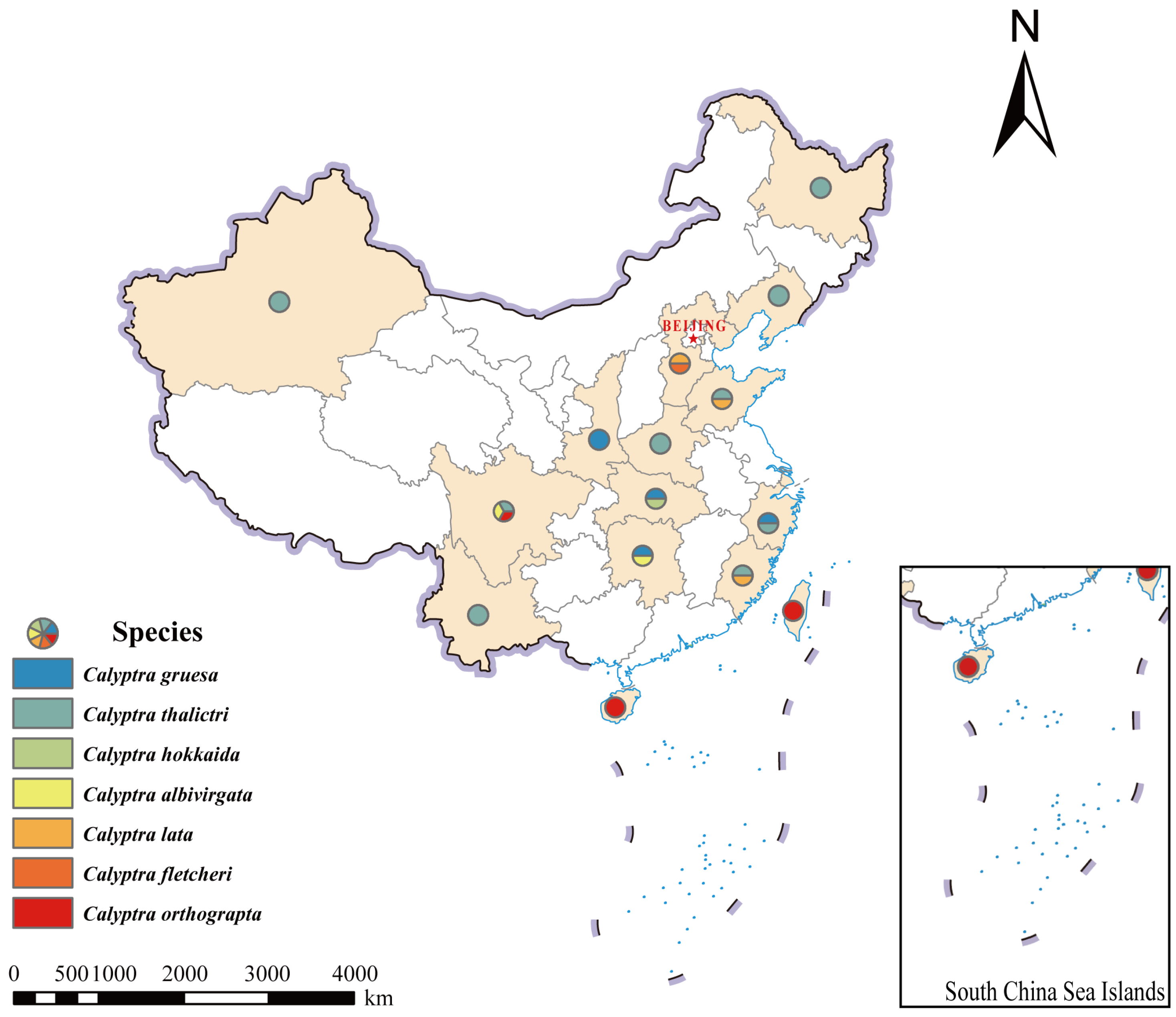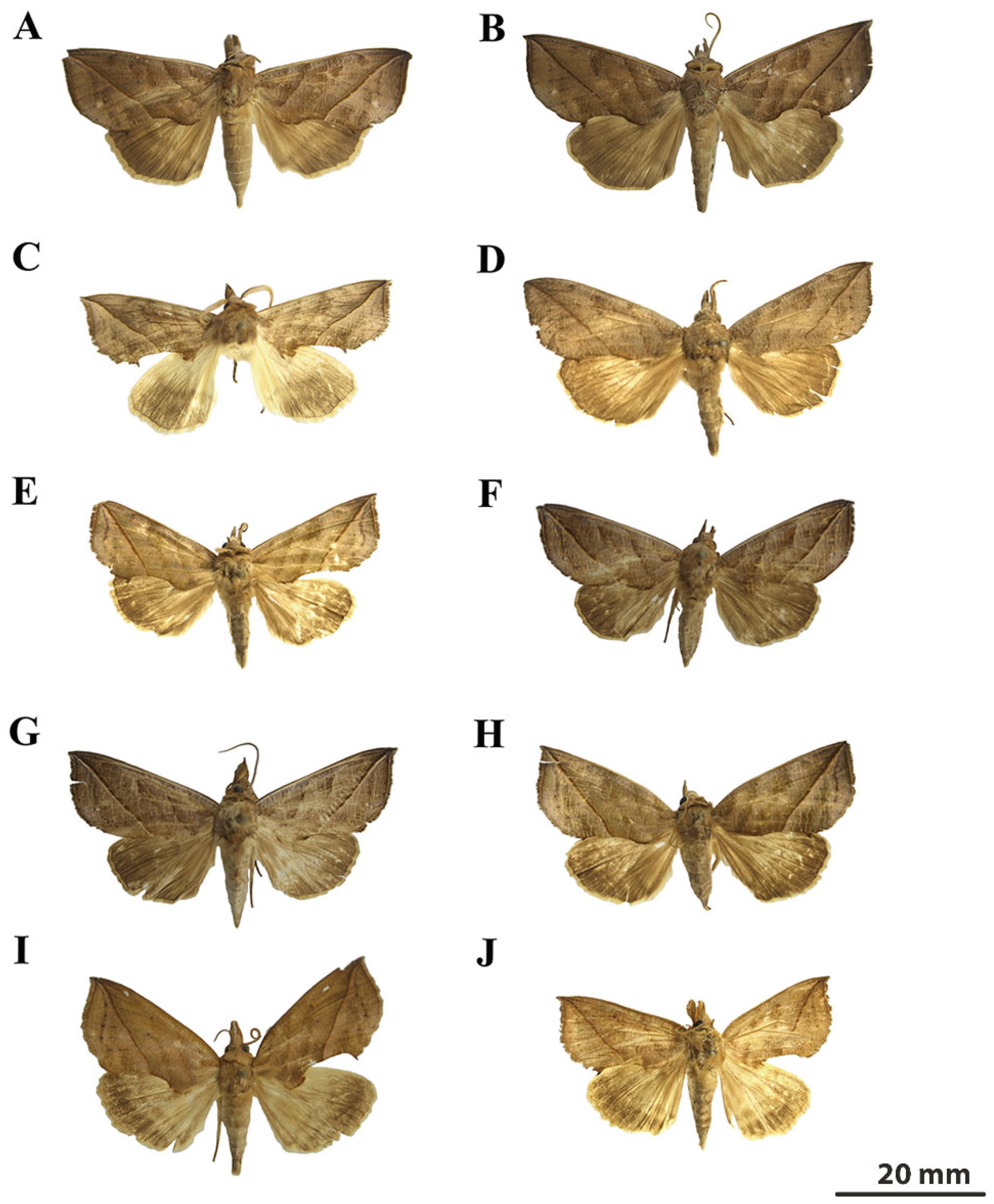Taxonomic Revision of Vampire Moths of the Genus Calyptra (Lepidoptera: Erebidae: Calpinae) in Chinese Fauna
Simple Summary
Abstract
1. Introduction
2. Materials and Methods
2.1. Morphological Study
2.2. Occurrence Data and Preparation of Map
3. Results
3.1. Taxonomic Overview of the Genus Calyptra
3.1.1. Calyptra gruesa (Draudt, 1950)
3.1.2. Calyptra thalictri (Borkhausen, 1790)
3.1.3. Calyptra hokkaida (Wileman, 1922)
3.1.4. Calyptra albivirgata (Hampson, 1926)
3.1.5. Calyptra orthograpta (Butler, 1886)
3.1.6. Calyptra lata (Butler, 1881)
3.1.7. Calyptra fletcheri (Berio, 1956)
3.2. Key to the Species of Genus Calyptra
- 1. Androtheca present on male tibia II ....................................................................................... 2
- – Androtheca absent ...................................................................................................................... 6
- 2. Forewing reddish-brown; tornal hook distinct; white spots variable ……..... C. albivirgata
- – Forewing greyish or yellow-brown; other features diagnostic ............................................. 3
- 3. Forewing elongate; hindwing fringe yellow with dark outer edge ............. C. orthograpta
- – Forewing not elongate; fringe pale or uniform ....................................................................... 4
- 4. Diagonal line reddish-brown, distinct; tornal hook prominent ................................. C. lata
- – Diagonal line faint or curved; tornal hook reduced ............................................................... 5
- 5. Forewing olive green; diagonal line bordered greenish ....................................... C. hokkaida
- – Forewing greyish-brown with pink striations ......................................................... C. thalictri
- 6. Forewing purplish-gray; yellowish subterminal spot near Cu1 ............................. C. gruesa
- – Forewing rufous; diagonal line dark, bordered red ............................................... C. fletcheri
3.3. World Checklist of Calyptra Ochsenheimer, 1816: 78
- C. nyei Bänziger, 1979 India (Naga Hills) [43].
- C. ophideroides (Guenée, 1852) (Calpe) “Indes Orientales” (E. indies specifically, the regions of Southeast Asia, including Indonesia and surrounding areas) [42].
- C. parva Bänziger, 1979 India (Naga Hills, Manipur) [43].
- C. pseudobicolor Bänziger, 1979 India (Sikkim), Myanmar, Bhutan (Toungho) [43].
4. Discussion
Author Contributions
Funding
Data Availability Statement
Acknowledgments
Conflicts of Interest
References
- Bänziger, H. A taxonomic revision of the fruit-piercing and blood-sucking moth genus Calyptra Ochsenheimer, Calpe Treitschke (Lepidoptera: Noctuidae). Entomol. Scand. 1983, 14, 467–491. [Google Scholar] [CrossRef]
- Zaspel, J.M.; Branham, M.A. World checklist of tribe Calpini (Lepidoptera: Noctuidae: Calpinae). Insecta Mundi 2008, 47, 1–15. [Google Scholar]
- Zaspel, J.M.; Scott, C.H.; Hill, S.R.; Ignell, R.; Kononenko, V.S.; Weller, S.J. Geographic distribution, phylogeny, and genetic diversity of the fruit-and blood-feeding moth Calyptra thalictri Borkhausen (Insecta: Lepidoptera: Erebidae). J. Parasitol. 2014, 100, 583–591. [Google Scholar] [CrossRef]
- Kitching, I.J.; Rawlins, J.E. The Noctuoidea. In Lepidoptera, Moths and Butterflies, Vol. 1: Evolution, Systematics and Biogeography; Kristensen, N.P., Ed.; Walter de Gruyter: Berlin, Germany, 1998; Volume IV, pp. 355–401. [Google Scholar]
- Fibiger, M.; Lafontaine, J.D. A review of the higher classification of the Noctuoidea (Lepidoptera) with special reference to the Holarctic fauna. Esperiana Buchr. Entomol. 2005, 11, 1–205. [Google Scholar]
- Lafontaine, J.D.; Fibiger, M. Revised higher classification of the Noctuoidea (Lepidoptera). Can. Entomol. 2006, 138, 610–635. [Google Scholar] [CrossRef]
- Mitchell, A.; Mitter, C.; Regier, J.C. Systematics and evolution of the cutworm moths (Lepidoptera: Noctuidae): Evidence from two protein-coding nuclear genes. Syst. Entomol. 2006, 31, 21–46. [Google Scholar] [CrossRef]
- Zahiri, R.; Holloway, J.D.; Kitching, I.J.; Lafontaine, J.D.; Mutanen, M.; Wahlberg, N. Molecular phylogenetics of Erebidae (Lepidoptera, Noctuoidea). Syst. Entomol. 2012, 37, 102–124. [Google Scholar] [CrossRef]
- Holloway, J.D. Moths of Borneo; The Natural History Publications: Kota Kinabalu, Malaysia, 2005. [Google Scholar]
- Goater, B.; Ronkay, L.; Fibiger, M. Catocalinae and Plusiinae. Noctuidae Europeae Vol. 10; Entomological Press: Sorø, Denmark, 2003; p. 452. [Google Scholar]
- Bänziger, H. Skin-piercing blood-sucking moths V: Attacks on man by 5 Calyptra spp. (Lepidoptera: Noctuidae) in S. and S.E. Asia. Mittellungen Schweiz. Entomol. Ges. 1989, 62, 215–233. [Google Scholar]
- Bänziger, H. Skin-piercing blood-sucking moths VI: Fruit-piercing habits in Calyptra (Noctuidae) and notes on the feeding strategies of zoophilous and frugivorous adult Lepidoptera. Mittellungen Schweiz. Entomol. Ges. 2007, 80, 271–288. [Google Scholar]
- Zaspel, J.M.; Kononenko, V.S.; Goldstein, P.Z. Another blood feeder? Experimental feeding of a fruit-piercing moth species on human blood in the Primorye territory of far eastern Russia (Lepidoptera: Noctuidae: Calpinae). J. Insect Behav. 2007, 20, 437–451. [Google Scholar] [CrossRef]
- Bänziger, H. Vampire Moths Behavior, Ecology and Taxonomy of Blood-Sucking Calyptra; Natural History Publications (Borneo): Kota Kinabalu, Malaysia, 2021; ISBN 978-983-812-199-6. [Google Scholar]
- Bänziger, H. Detailed data on proboscis length and structure in Calyptra species. Mittellungen Schweiz. Entomol. Ges. 1986, 75, 112–123. [Google Scholar]
- Chen, Y.X. Fauna Sinica: Insecta, Volume 16: Lepidoptera: Noctuidae; Science Press: Beijing, China, 1999; pp. 1186–1190. (In Chinese) [Google Scholar]
- Landry, J.F. Taxonomic review of the leek moth genus Acrolepiopsis (Lepidoptera: Acrolepiidae) in North America. Can. Entomol. 2007, 139, 319–353. [Google Scholar] [CrossRef]
- Yang, Z.; Landry, J.F.; Handfield, L.; Zhang, Y.; Alma Solis, M.; Handfield, D.; Scholtens, G.; Mutanen, M.; Nuss, M.; Hebert, P. DNA barcoding and morphology reveal three cryptic species of Anania (Lepidoptera: Crambidae: Pyraustinae) in North America, all distinct from their European counterpart. Syst. Entomol. 2012, 37, 686–705. [Google Scholar] [CrossRef]
- Available online: http://bzdt.ch.mnr.gov.cn (accessed on 28 April 2025).
- Esri. ArcGlS Desktop: Release 10.8; Environmental systems Research Institute: Redlands, CA, USA, 2020. [Google Scholar]
- Ochsenheimer, F. Die Schmetterlinge Europas; Fleischer: Leipzig, Germany, 1816; Volume 4. (In German) [Google Scholar]
- Duponchel, P.A.J. Godart & Duponchel. In Histoire Naturelle des Lépidoptères ou Papillonsde France; Crevot: Paris, France, 1826; Volume 6. (In French) [Google Scholar]
- Treitschke, F. Die Schmetterlinge Europas; Fleischer: Leipzig, Germany, 1825; Volume 5. (In German) [Google Scholar]
- Butler, A.G. On a collection of Indian Lepidoptera received from Lieut.-Colonel Charles Swinhoe; with numerous notes by the collector. Proc. Zool. Soc. Lond. 1883, 144–175. [Google Scholar]
- Moore, F. Description of New Indian Lepidopterous Insects from the Collection of the Late Mr. W. S. Atkinson. Heterocera; Asiatic Society of Bengal: Calcutta, India, 1882. [Google Scholar]
- Sugi, S. Illustrations of the Taiwanese Catocala, with descriptions of two new species. Noctuidae Taiwan I Tyo Ga 1982, 32, 147–163. [Google Scholar]
- Butler, A.G. Description of new species of Heterocera from Japan. Ann. Mag. Nat. Hist. 1878, 1, 192–204. [Google Scholar] [CrossRef]
- Schwingenschuss, L. Sechster Beitrag zur Lepidopterenfauna Inner-Anatoliens. Entomol. Rundsch. 1938, 55, 454–457. (In German) [Google Scholar]
- Dannehl, F. Neue Formen und Lokalrassen. Entomol. Z. 1925, 39, 11–12. (In German) [Google Scholar]
- Lelej, A.S. Annotated Catalogue of the Insects of Russian Far East. Volume II. Lepidoptera; Dalnauka: Vladivostok, Russia, 2016; 812p. [Google Scholar]
- Poujade, G.A. Description d’une nouvelle espèce de Noctuélides. Ann. Sociétéentomol. France 1887, 7, 137–146. (In French) [Google Scholar]
- Graeser, L. Beiträge zur Kenntniss der Lepidopteren-Fauna des Amurlandes, Teil III. Berl. Entomol. Z. 1889, 33, 251–268. (In German) [Google Scholar] [CrossRef]
- Hampson, G.F. Description of New Genera and Species of Lepidoptera Phalaenae of the Subfamily Noctuinae (Noctuidae) in the British Museum; Trustees of the British Museum (Natural History): London, UK, 1926. [Google Scholar]
- Moore, F. Description of new genera and species of Asiatic Lepidoptera. Proc. Zool. Soc. Lond. 1883, 51, 521–580. [Google Scholar] [CrossRef]
- Moore, F. The Lepidoptera of Ceylon; L. Reeve and Co.: London, UK, 1884; Volume 3, 578p, pp. 144–215. [Google Scholar]
- Cotes, E.C.; Swinhoe, C. A Catalogue of the Moths of India (Part II: Bombyces); Printed by Order of the Trustees of the Indian Museum; Trustees of the Indian Museum: Calcutta, India, 1887. [Google Scholar]
- Berio, E. Appunti su alcune apecie del genere Calpe Tr. (Lepidoptera: Noctuidae). Mem. Soc. Entomol. Ital. 1956, 35, 109–119. [Google Scholar]
- Draudt, M. Beiträge zur Kenntnis der Agrotiden-Fauna Chinas Aus den Ausbeuten Dr. H.Höne’s. Mitteilungen Münchner Entomol. Ges. 1950, 40, 1–174. (In German) [Google Scholar]
- Wileman, A.E. On a new species of genus Calpe from Japan. Entomologist 1922, 55, 197–199. [Google Scholar]
- Grünberg, K. Eine Lepidopteren-Ausbeute des Kiwu-See. Soc. Entomol. 1910, 23, 145–148. (In German) [Google Scholar]
- Butler, A.G. Description of new genera and species of Heterocera from Japan. Trans. Entomol. Soc. Lond. 1881, 29, 579–600. [Google Scholar] [CrossRef]
- Guenée, M.A. Boisduval & Guenée. In Histoire Naturelle des Insectes (Lépidoptères); Librairie Encyclopédique de Roret: Paris, France, 1852; Volume 6. (In French) [Google Scholar]
- Bänziger, H. Description of 3 new species of Calyptra Ochsenh. [Calpe Treit] (Lep., Noctuidae). Mitteilungen Schweiz. Entomol. Ges. 1979, 52, 103–108. [Google Scholar]
- Butler, A.G. Illustrations of Typical Specimens of Lepidoptera Heterocera in the Collection of the British Museum; Trustees of the British Museum (Natural History): London, UK, 1886; Volume 6, 89p. [Google Scholar]
- Prout, L.B. Description of some Indo-Australian Noctuidae. Bull. Hill Mus. 1928, 2, 256–270. [Google Scholar]
- Borkhausen, M.B. Systematische Beschreibung der Europäischen Schmetterlinge; Teil III; Varrentrapp & Wenner: Frankfurt, Germany, 1790. (In German) [Google Scholar]
- Bethune, C.J.S. Descriptions of three new species of Canadian Nocturnal Lepidoptera. Proc. Entomol. Soc. Phila. 1865, 4, 213–215. [Google Scholar]
- Zaspel, J.M.; Zahiri, R.; Hoy, M.A.; Janzen, D.; Weller, S.J.; Wahlberg, N. A molecular phylogenetic analysis of the vampire moths and their fruit-piercing relatives (Lepidoptera: Erebidae: Calpinae). Mol. Phylogenet. Evol. 2012, 65, 786–791. [Google Scholar] [CrossRef]
- Zaspel, J.M. Systematics, Biology, and Behavior of Fruit-Piercing and Blood-Feeding Moths in the Subfamily Calpinae (Lepidoptera: Noctuidae). Master’s Thesis, University of Florida, Gainesville, FL, USA, 2008. [Google Scholar]




Disclaimer/Publisher’s Note: The statements, opinions and data contained in all publications are solely those of the individual author(s) and contributor(s) and not of MDPI and/or the editor(s). MDPI and/or the editor(s) disclaim responsibility for any injury to people or property resulting from any ideas, methods, instructions or products referred to in the content. |
© 2025 by the authors. Licensee MDPI, Basel, Switzerland. This article is an open access article distributed under the terms and conditions of the Creative Commons Attribution (CC BY) license (https://creativecommons.org/licenses/by/4.0/).
Share and Cite
Bashir, A.; Cui, Y.; Dong, Y.; Yang, Z. Taxonomic Revision of Vampire Moths of the Genus Calyptra (Lepidoptera: Erebidae: Calpinae) in Chinese Fauna. Insects 2025, 16, 534. https://doi.org/10.3390/insects16050534
Bashir A, Cui Y, Dong Y, Yang Z. Taxonomic Revision of Vampire Moths of the Genus Calyptra (Lepidoptera: Erebidae: Calpinae) in Chinese Fauna. Insects. 2025; 16(5):534. https://doi.org/10.3390/insects16050534
Chicago/Turabian StyleBashir, Asad, Yuqi Cui, Yanling Dong, and Zhaofu Yang. 2025. "Taxonomic Revision of Vampire Moths of the Genus Calyptra (Lepidoptera: Erebidae: Calpinae) in Chinese Fauna" Insects 16, no. 5: 534. https://doi.org/10.3390/insects16050534
APA StyleBashir, A., Cui, Y., Dong, Y., & Yang, Z. (2025). Taxonomic Revision of Vampire Moths of the Genus Calyptra (Lepidoptera: Erebidae: Calpinae) in Chinese Fauna. Insects, 16(5), 534. https://doi.org/10.3390/insects16050534






